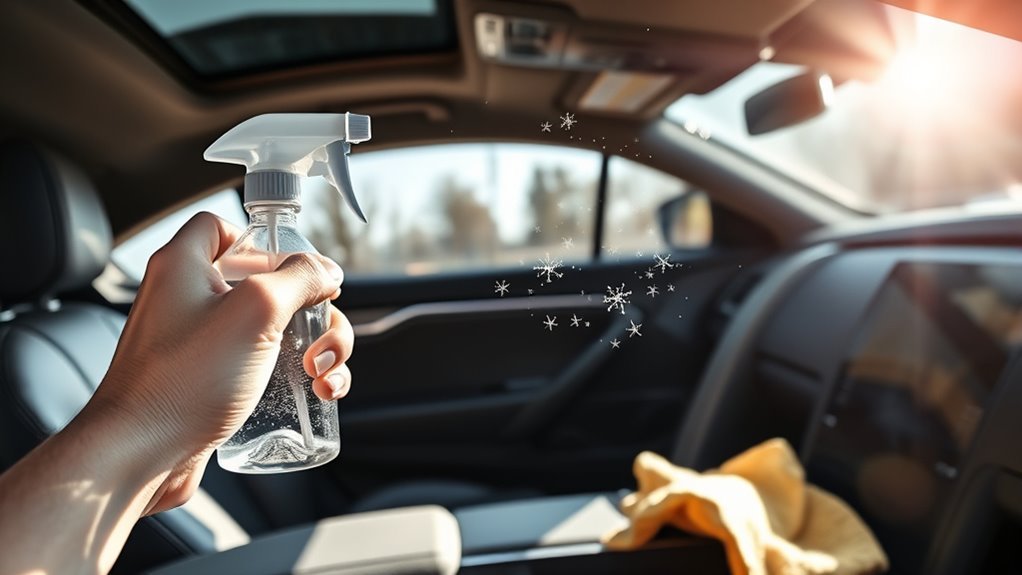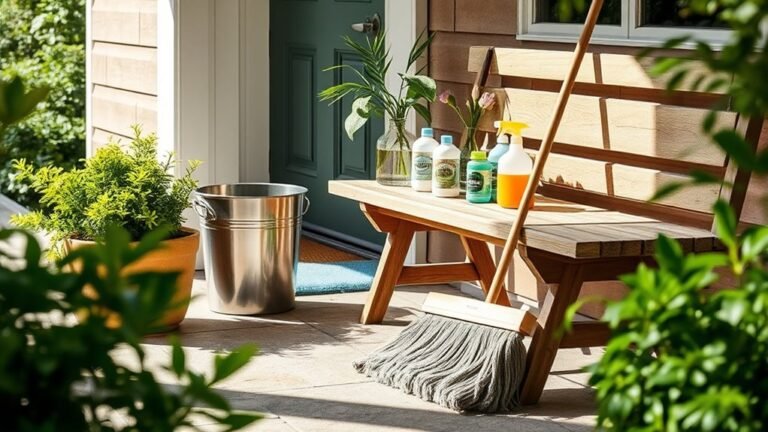Best Way to Sanitize Your Car
To sanitize your car effectively, start by clearing out clutter and vacuuming to remove dirt. Focus on high-touch spots like the steering wheel, door handles, and gear shift using disinfectant wipes or sprays safe for your car’s surfaces. Wear gloves and maintain good ventilation while cleaning. Use EPA-approved, alcohol-based products for best results. Regularly revitalizing your routine keeps germs at bay and your car fresh. Keep going to discover expert tips and extra precautions for shared rideshare vehicles.
Essential Supplies for Car Sanitization

To effectively sanitize your car, you’ll need a few essential supplies that target germs without damaging surfaces. Start with high-quality sanitization tools like microfiber cloths, which trap dirt and bacteria without scratching. Choose a disinfectant spray formulated for automotive interiors to guarantee thorough car cleaning without harsh chemicals. Don’t forget disposable gloves to protect your hands and avoid cross-contamination. You’ll also want a soft-bristle brush for hard-to-reach areas and vents, making sure every corner gets attention. Having a portable vacuum can help remove dust and debris before sanitizing. With these supplies, you can take control of your car’s cleanliness, guaranteeing a safe, fresh ride that supports your freedom to travel with peace of mind. These tools make the process efficient and effective, so you’re ready to hit the road confidently.
Preparing Your Car for Cleaning
How do you get your car ready for a thorough cleaning? Start by clearing out all personal items—this clears your space and mind, making the cleaning routine smoother. Next, give your car a quick vacuum to remove loose dirt and debris that can interfere with effective sanitizing. Don’t forget to open all doors and windows for better ventilation during the process. Car prep also means checking for any stains or sticky spots that need extra attention. By taking these simple steps, you set yourself up for a more efficient and freeing cleaning experience. Prepping your car isn’t just about tidiness—it’s about creating a clean slate so you can reclaim control of your environment effortlessly.
Effective Cleaning Techniques for High-Touch Areas

You’ll want to focus on high-touch areas like door handles, steering wheels, and seat belts when sanitizing your car. Choosing the right cleaning products is key to protect surfaces without causing damage. Follow a simple step-by-step process to guarantee these spots are thoroughly cleaned and disinfected.
Identifying High-Touch Surfaces
Several surfaces inside your car get touched more often than others, making them hotspots for germs and bacteria. To keep your ride fresh and safe, start by identifying these high touch items. Think about your steering wheel, door handles, gear shift, seat belts, and control buttons. These areas see constant contact, so they demand your attention.
Understanding the surface materials matters too. Leather, plastic, metal, and fabric each respond differently to cleaning methods, so knowing what you’re dealing with helps you protect your car’s interior while effectively removing germs. Focus on these key spots regularly, and you’ll maintain a cleaner, healthier environment inside your vehicle, giving you the freedom to enjoy your drive without worry.
Choosing Safe Cleaning Products
Now that you know which spots inside your car need the most attention, it’s important to pick cleaning products that won’t damage those surfaces while effectively killing germs. You want products that strike the perfect balance between product effectiveness and preserving your car’s materials. Choosing eco friendly options lets you keep your space fresh without harsh chemicals that could harm your health or the environment. Look for cleaners labeled safe for plastics, leather, and touchscreens—these guard against fading or cracking. Don’t overlook disinfectants approved by health authorities to guarantee they truly eliminate bacteria and viruses. By selecting the right products, you maintain your car’s integrity and enjoy peace of mind, freeing you to hit the road confidently, knowing you’ve sanitized your high-touch areas safely and effectively.
Step-by-Step Sanitizing Process
Before you plunge into sanitizing your car, it’s essential to follow a clear, step-by-step process that targets the high-touch areas effectively. Start by wiping down steering wheels, door handles, and gear shifts with disinfectant wipes. These spots collect the most germs, so focus here first. Next, use steam cleaning for your car’s upholstery care—it kills bacteria without harsh chemicals, keeping your seats fresh and safe. Don’t forget seat belts and buttons on the dashboard; a microfiber cloth dipped in a mild cleaner works well. After cleaning, let your car air out to prevent any lingering chemical smells. Following this routine not only frees you from worry but keeps your car a safe, clean space wherever you roam.
Choosing Safe and Effective Disinfectants

Anyone looking to keep their car truly clean needs to pick disinfectants that are both safe for surfaces and effective against germs. You want to avoid harsh chemicals that can damage your interior or leave harmful residues. Check the disinfectant ingredients—look for ones proven to kill viruses and bacteria without being abrasive. If you value freedom in your choices and care about the planet, consider eco friendly options like those based on hydrogen peroxide or plant-derived compounds. These alternatives protect your car and the environment without compromising effectiveness. Always read labels carefully and test products on small areas first to verify they won’t harm leather, plastics, or fabric. Choosing the right disinfectant means you maintain a germ-free space while respecting your car’s materials and your personal values.
Tips for Maintaining a Germ-Free Interior
Selecting the right disinfectants sets the stage for keeping your car’s interior truly germ-free. To maintain that cleanliness and protect your freedom from unwanted germs, focus on these key strategies:
- Target germ hotspots like door handles, steering wheels, and seat belts regularly.
- Use disinfectant wipes safe for interior fabrics to avoid damage while killing germs.
- Vacuum and steam clean interior fabrics weekly to remove dirt and bacteria deeply embedded.
- Keep hand sanitizer handy for quick use after touching surfaces outside your car.
Additional Precautions for Shared or Rideshare Vehicles
If you’re using a shared or rideshare vehicle, make sure you have essential cleaning supplies like disinfectant wipes and hand sanitizer on hand. Focus especially on high-touch surfaces such as door handles, seat belts, and touchscreens. Taking these extra steps can help keep you safer between rides.
Essential Cleaning Supplies
While cleaning your personal car might require only basic supplies, shared or rideshare vehicles demand a more thorough approach to prevent germ transmission. To keep your space safe and fresh, you’ll need reliable cleaning tools and effective sanitizing wipes. Here’s what you should have on hand:
- Disinfectant sprays – Choose ones approved to kill viruses and bacteria quickly.
- Sanitizing wipes – Perfect for quick, targeted cleaning on the go.
- Microfiber cloths – These trap dirt without scratching surfaces, letting you clean efficiently.
- Gloves and masks – Protect yourself during the cleaning process, especially in shared environments.
Armed with these essentials, you can maintain your vehicle’s cleanliness and enjoy the freedom of a safe ride every time.
High-Touch Surface Focus
Keeping the right cleaning supplies handy is just the start when it comes to sanitizing shared or rideshare vehicles. You need to zero in on high touch items like door handles, seat belts, steering wheels, and touchscreen controls. These spots are surface vulnerabilities where germs easily settle, so giving them extra attention is key. Don’t forget areas like window buttons, cup holders, and armrests—any place hands frequently touch. By targeting these vulnerable surfaces, you reduce the risk of transferring unwanted bacteria or viruses, keeping your ride fresh and safe. Taking these extra precautions lets you enjoy the freedom of mobility without compromising your health. Stay proactive, and make high-touch surface focus a habit every time you share your car or hop into a rideshare.
Frequently Asked Questions
Can UV Light Be Used to Sanitize Car Interiors?
Using UV light to sanitize your car interiors can be as effective as a sunbeam cutting through a cloudy day, but you’ll want to understand UV efficiency to get the best results. UV light can kill bacteria and viruses on surfaces, but safety is key—UV safety precautions must be followed to avoid skin or eye damage. If you’re seeking a chemical-free method, UV sanitizing offers a liberating way to keep your space clean.
How Often Should Air Filters Be Replaced to Reduce Germs?
You should replace your car’s air filters every 12,000 to 15,000 miles or at least once a year to stay ahead in filter maintenance and maximize germ reduction. Keeping up with this routine lets you breathe easier and keeps your space fresh without hassle. Don’t wait for signs of dirt buildup—staying proactive gives you the freedom to enjoy a cleaner, healthier ride every time you hit the road.
Are Antimicrobial Seat Covers Effective Against Bacteria?
Imagine your car seats as a fortress against unseen invaders. Antimicrobial materials in seat covers act like modern knights, constantly battling bacteria to keep your space cleaner. You’ll enjoy seat cover benefits like reduced odors and less germ buildup, giving you more freedom from worries about hygiene. While they’re not a magic shield, these covers greatly lower bacteria, making your ride healthier and more comfortable on every journey you take.
Can Essential Oils Help in Sanitizing Car Surfaces?
You might find essential oils helpful for car odor elimination, thanks to their natural antimicrobial properties. While they offer essential oil benefits like a pleasant scent and some germ-fighting ability, they’re not a complete sanitizer on their own. If you want freedom from harsh chemicals, using essential oils alongside proper cleaning can freshen your ride and reduce bacteria but shouldn’t replace thorough disinfecting methods for full sanitation.
Is Steam Cleaning Safe for All Car Interior Materials?
You might wonder if steam cleaning is safe for all car interior materials. While steam cleaning benefits include deep sanitizing and eco-friendliness, it’s not always compatible with every surface. Delicate fabrics, leather, or certain plastics can be damaged by excessive heat and moisture. So, you’ll want to check your car’s material compatibility before diving in. That way, you keep your freedom to clean confidently without risking harm.






